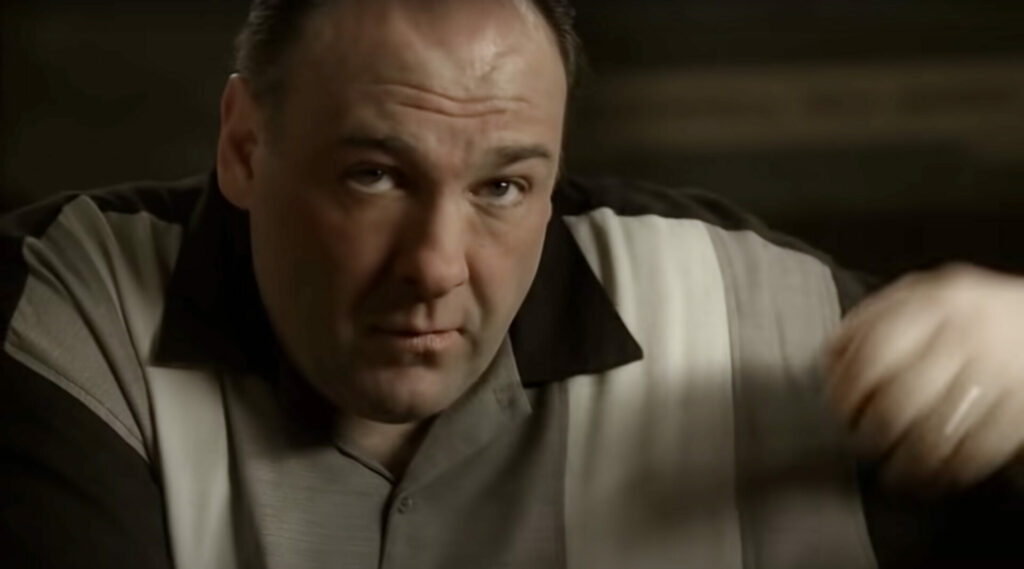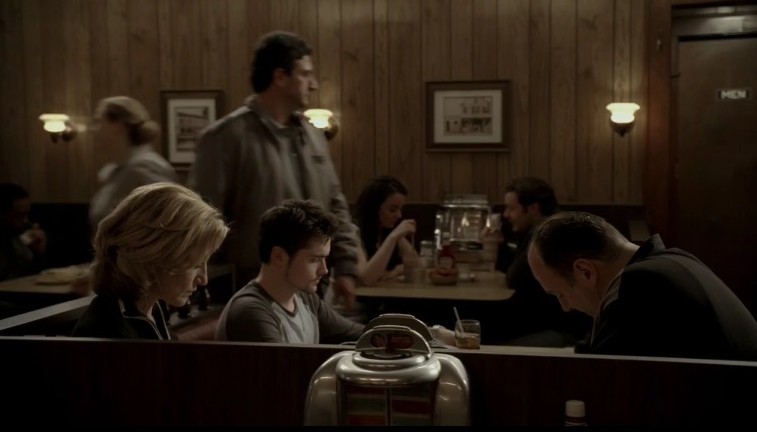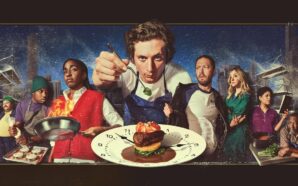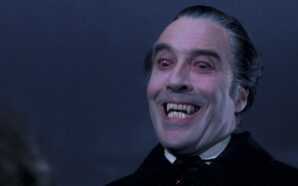There are no new takes when it comes to the ending of The Sopranos. Undoubtably the most famous final scene of any television series, it’s been picked apart relentlessly for sixteen years. Everybody’s got a theory on what happens to Tony Soprano as he sits in that diner and the screen cuts to black and silence. I’ve just completed a rewatch of the series and throughout was eager to see if my thoughts, my theory, would change on this most recent viewing. In a way, it did. I thought, wait a minute, why are we all competing to have the ‘right’ answer, arguing that we’ve ‘solved’ the mystery, when the lack of the answer is the answer itself? I reject the need to subscribe to a theory.
The preeminent thesis, the one with the most supposed evidence, is that Tony dies in that final moment of the show:
- In the premiere of the final season (counting season 6B as its own season) Tony has a conversation about death with his brother-in-law Bobby, who says, “you probably don’t even hear it when it happens, right.” This moment is shown again at the end of the penultimate episode when Tony thinks about Bobby, who has just been killed. The cut to black could be a way of presenting Tony’s death the way he would experience it: sudden, unforeseen nothingness.
- Earlier in the season, Silvio is eating in a restaurant with a New York gangster who is unexpectedly shot. He doesn’t hear the first shot, and neither does the audience. Instead we are presented with sudden silence and the first indication of death being blood splatter on Sil’s face. This scene could be conditioning the audience on how the final death will be presented.
- Eugene killed someone at a diner in the season 6 premiere while wearing a Members Only jacket, just like the one Tony’s possible killer is wearing, the shifty looking guy seen at the counter and then walking to the restroom. I think the jacket is more an almost subconscious connection to a hit than a direct clue that the shooter is connected to Eugene.
- The editing of the finale often shows Tony’s reaction to something and then a reverse shot of what he is looking it. The final moments could follow this: we see Tony and then we see what he sees: nothing.
- There is a shot of two black men in the diner. African Americans are used as a scapegoat for multiple crimes and murders throughout the show, like Jackie Jr’s murder, even with an episode named after the phenomena, Unidentified Black Males.
- The last we see of the possible killer is him walking to the restroom, just like Michael Corleone does in The Godfather to acquire a gun before shooting his father’s attackers in the restaurant. This is Tony’s favourite scene and perhaps his final moments play out like it.
- Some viewers see Meadow as her father’s guardian angel. She saved him from being shot in the season 1 episode College, and was the voice that beckoned him from the limbo afterlife in Mayham. Without her there, Tony is left unprotected, whether supernaturally or just literally because she would be blocking him from the gunman.
- The episode begins with a shot of Tony laying like he’s in a coffin, and death imagery and symbolism is rife throughout the show, particularly the final season.
- Tony’s rival Phil Leotardo is shot suddenly earlier in the episode, never seeing what was coming, never realising he was going to die.

A further expansion on the idea of Tony dying is that not only is he dead but what we are seeing is actually Tony in hell, reexperiencing his death:
- After waking from his near-death experience in season 2, Christopher says he visited hell and saw his father, Dickie Moltisanti, who was condemned to experience his death over and over. Tony could be experiencing the same.
- The way the opening of the scene is edited, it’s almost like Tony walks into the diner and sees himself sat there. Maybe that ring of the bell of the door opening in the show’s final second is Tony walking in, the end of one loop being the beginning of another.
- Christopher also had a warning for Tony and Paulie from hell: three o’ clock. For Paulie this may relate to his cancer diagnosis when he wakes and calls the doctor at 3am, before having a vision of the Virgin Mary. If the man in the Members Only jacket is Tony’s killer, he would approach and shoot Tony from his three o’ clock position.
- Tony almost went to hell, in the form of ‘The Inn at the Oaks,’ after being shot in season 6, but was pulled back and given a new chance which, like pretty much everyone else in the final season, he squandered, refusing to change. He accepted who he was, a hellbound man, in the final moments of Kennedy and Heidi.
- Christopher narrates The Many Saints of Newark from hell so, if taken on literal face value rather than a mere storytelling tool, it exists as an actual plane of existence in the world of The Sopranos.
If Tony is killed, then who is the killer? Really, it’s David Chase, the show’s creator and the episode’s writer/director, who created and ended the character. But as for a literal, in-universe person who hired the hitman to kill Tony, I think the obvious answer would be Butchie or any other surviving member of the New York family. Although, Paulie is a possibility. There are specific shots and moments in the finale to show how Paulie is unsatisfied and offended by Tony, seemingly mulling something over in his mind. And then there are multitudes of other possibilities; dozens from over the seasons would want Tony dead. Although this is one area I have never felt compelled to theorise about. Even if you think Tony is killed, it doesn’t matter who the one to do it was. We don’t know because in that moment Tony doesn’t know, and will never know.
Several times throughout the series, Tony says that people like him wind up either dead or arrested. If Tony isn’t dead, perhaps he’s arrested at the end of the show. His life as he knows it comes to an end with that ding of the door opening as the FBI enter and arrest him. As the show concludes, Carlo is arrested and said to have been flipped, making Tony’s arrest, whether in that specific moment or not, imminent.

And the final significant theory on the end of The Sopranos is that absolutely nothing happens in the final scene. The family share a meal. Life goes on but the point is that it could end at any moment for Tony. That is the life he leads: any moment could be his last. We witness, and are left on the feeling, of Tony’s constant anxiety. The cut to black ensures that’s the feeling we’ll be forever left on. A gunman could fire or the FBI could arrest him at any time of any day. Maybe it’s then or maybe it’s not. Tony lives in fear and trepidation of the opening of every door.
The cut to black could also be that we just have nothing left to see. That’s all folks. We have come to understand Tony as much as we can and are no longer privy to his life. The sudden stop is emblematic of the show ending and is purely for us, the audience, to feel the pain of being cut off. For the Sopranos life goes on but this is where our journey with them ends.
Why list all these theories? Because they are all true, every bullet point and paragraph, even the contradictory ones. As much as David Chase now likes teasing that Tony is dead, the show speaks for itself. The art is the true authority. If there was an answer then the show would end with it a certainty. The uncertainty is the ending. Mystery and ambiguity is the point.
Tony is Schrödinger’s Soprano, forever in a state of dead/alive. He’s not one or the other but both at once, depending which train of thought is followed. The box will never be opened. He’ll remain as such forever, no answer forthcoming, and I embrace that. As much as I have listed clues and evidence, ultimately this is not a mystery to be solved but a mystery to be endured, embraced, and relished.









[…] Motion pictures with ambiguous endings are constructed to maintain us guessing, and American Psycho nails that completely. Nevertheless, it’s in good firm with some classics just like the 1999 drama collection, The Sopranos. Viewers have been left hanging after the display screen immediately went black and, after seven seasons of watching Tony Soprano name the photographs, we have been left questioning — did he get whacked in that diner? We’ll by no means know, and that’s the point. […]
[…] Movies with ambiguous endings are built to keep us guessing, and American Psycho nails that perfectly. However, it’s in good company with some classics like the 1999 drama series, The Sopranos. Viewers were left hanging after the screen suddenly went black and, after seven seasons of watching Tony Soprano call the shots, we were left wondering — did he get whacked in that diner? We’ll never know, and that’s the point. […]
[…] Movies with ambiguous endings are built to keep us guessing, and American Psycho nails that perfectly. However, it’s in good company with some classics like the 1999 drama series, The Sopranos. Viewers were left hanging after the screen suddenly went black and, after seven seasons of watching Tony Soprano call the shots, we were left wondering — did he get whacked in that diner? We’ll never know, and that’s the point. […]
[…] অস্পষ্ট সমাপ্তি সহ চলচ্চিত্রগুলি আমাদের অনুমান করতে তৈরি করা হয়, এবং আমেরিকান সাইকো নখ যে পুরোপুরি. যাইহোক, এটি 1999 সালের নাটক সিরিজের মতো কিছু ক্লাসিকের সাথে ভাল সঙ্গী, সোপ্রানোস. স্ক্রিনটি হঠাৎ কালো হয়ে যাওয়ার পরে দর্শকরা ঝুলে পড়েছিল এবং টনি সোপ্রানোকে শটগুলি ডাকার সাতটি মরসুম দেখার পরে, আমরা অবাক হয়েছিলাম – তিনি কি সেই ডিনারে মার খেয়েছিলেন? আমরা জানব না, এবং যে বিন্দু. […]
[…] Motion pictures with ambiguous endings are constructed to maintain us guessing, and American Psycho nails that completely. Nonetheless, it’s in good firm with some classics just like the 1999 drama sequence, The Sopranos. Viewers have been left hanging after the display screen all of the sudden went black and, after seven seasons of watching Tony Soprano name the photographs, we have been left questioning — did he get whacked in that diner? We’ll by no means know, and that’s the point. […]